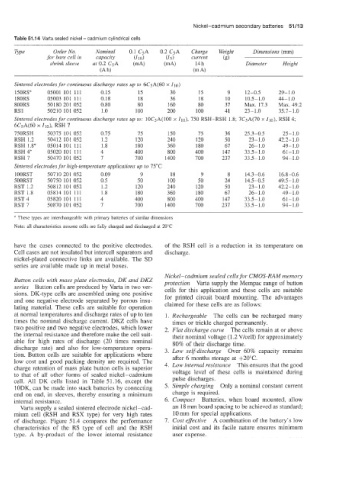Page 570 - Battery Reference Book
P. 570
Nickel-cadmium secondary batteries 51/13
Table 51.14 Varta sealed nickel -cadmium cylindrical cells
Type Order No. Nominal 0.1 C5A 0.2 C5A Charge Weight Dimensions (mm)
for bare cell in capacily (I101 (15) current (g)
shrink sleeve at 0.2 C5A (mA) (mA) 14h Diameter Height
(Ah) (m A)
~ ~ ~~ ~~~~~~~ ~~~
Sintered electrodes for continuous discharge rates up to 6CsA(60 x Ilo)
150RS* 05001 101 111 0.15 15 30 15 9 12-0.5 29-1.0
180RS 05003 101 111 0.18 18 36 18 10 10.5-1.0 44-1.0
800RS 501180 201 052 0.80 80 160 80 37 Max. 17.3 Max. 49.2
RS 1 508210 101 052 1 .o 100 200 100 41 23-1.0 35.7-1.0
Sintered electrodesfor continuous discharge rates up to: 1OC5A(lOO x Ilo), 750 RSH-RSH 1.8; 7CsA(70 x Ilo), RSH 4;
6CsA(6O x Ilo), RSH 7
750RSH 508375 101 052 0.75 75 150 75 36 25.3-0.5 25-1.0
RSH 1.2 50412 101 052 1.2 120 240 120 50 23-1.0 42.2-1.0
RSH 1.8* 05014 101 111 1.8 180 360 180 67 26-1.0 49-1.0
RSH 4" 05020 101 111 4 400 800 400 147 33.5-1.0 61-1.0
RSH 7 501470 101 052 7 700 1400 700 237 33.5-1.0 94-1.0
Sintered electrodes for high-temperature applications up to 75°C
lOORST 501710 201 052 0.09 9 18 9 8 14.3-0.6 16.8-0.6
5OORST 508750 101 052 0.5 50 100 50 24 14.5-0.5 49.5-1.0
RST 1.2 508812 101 052 1.2 120 240 120 50 23-1.0 42.2-1.0
RST 1.8 05814 101 111 1.8 180 360 180 67 26-1.0 49-1.0
RST 4 05820 101 111 4 400 800 400 147 33.5-1.0 61-1.0
RST 7 50870 101 052 7 700 1400 700 237 33.5-1.0 94- 1 .O
* These types are interchangeable with primary batteries of similar dimensions
Note: all characteristics assume cells are fully charged and discharged at 20°C
have the cases connected to the positive electrodes. of the RSH cell is a reduction in its temperature on
Cell cases are not insulated but intercell separators and discharge.
nickel-plated connective links are available. The SD
series are available made up in metal boxes.
Nickel-cudmium sealed cells for CMOS-RAM memory
Button cells with mass plate electrodes, DK and DKZ protection Varta supply the Mempac range of button
series Button cells are produced by Varta in two ver- cells for this application and these cells are suitable
sions. IDK-type cells are assembled using one positive
and one negative electrode separated by porous insu- for printed circuit board mounting. The advantages
claimed for these cells are as follows:
lating material. These cells are suitable for operation
at normal templeratures and discharge rates of up to ten 1. Rechargeable The cells can be recharged many
times the nominal discharge current. DKZ cells have times or trickle charged permanently.
two positive and two negative electrodes, which lower 2. Flat discharge curve The cells remain at or above
the internal resistance and therefore make the cell suit- their nominal voltage (1.2 Vkell) for approximately
able for high rates of discharge (20 times nominal 80% of their discharge time.
discharge rate) and also for low-temperature opera- 3. Low self-discharge Over 60% capacity remains
tion. Button cells are suitable for applications where after 6 months storage at +20°C.
low cost and good packing density are required. The 4. Low internal resistance This ensures that the good
charge retention of mass plate button cells is superior
to that of all ocher forms of sealed nickel-cadmium voltage level of these cells is maintained during
cell. All DK cells listed in Table 51.16, except the pulse discharges.
lODK, can be made into stack batteries by connecting 5. Simple charging Only a nominal constant current
end on end, in sleeves, thereby ensuring a minimum charge is required.
internal resistance. 6. Compact Batteries, when board mounted, allow
Varta supply a sealed sintered electrode nickel-cad- an 18 nun board spacing to be achieved as standard;
miurn cell (RSH and RSX type) for very high rates 10 mm for special applications.
of discharge. Figure 51.4 compares the performance 7. Cost effective A combination of the battery's low
characteristics of the RS type of cell and the RSH initial cost and its facile nature ensures minimum
type. A by-product of the lower internal resistance user expense.

